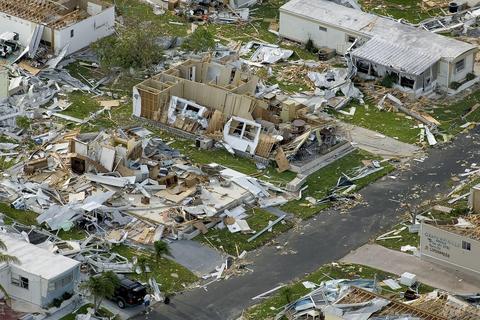Summary
The project develops next-generation procedures for achieving designs that are safe, sustainable, and economical under extreme winds, consistent with priorities described in the Measurement Science R&D Roadmap for Windstorm and Coastal Inundation Impact Reduction (NIST 2014). It supports these procedures with novel tools for accurate characterization of wind hazards, aerodynamic loading, and structural response to these effects. These tools include modern probabilistic, statistical, and machine-learning methods, efficient peak wind effects estimation methods, and Computational Wind Engineering methods applicable to bluff body aerodynamics calculations, supported by aerodynamics testing in the newly developed NIST civil engineering wind tunnel.
Description

Objective - To develop next-generation methods and tools to better characterize extreme wind hazards and associated loads, and response of structures to extreme winds, thus enabling performance-based standards for designing structures that resist extreme winds.
What is the new technical idea? The technical ideas include (1) determination and quantification of extreme wind hazards, (2) development of methods using state of the art measurement and computational technologies for determining wind loads on the building envelope and main wind force resisting system, and (3) development of performance-based design methods for wind-resistant design. These technical ideas support topics that have all been identified by the professional community in the new Measurement Science R&D Roadmap for Windstorm and Coastal Inundation Impact Reduction (NIST 2014) as being high priority.
The project uses the capabilities of numerical computation, data science, and spatial and temporal statistics to develop new procedures to estimate wind hazards with superior accuracy, and for any mean recurrence interval required for the development of the ASCE 7 Standard or other standards. An improved hazard estimation will not only help reduce losses, it can also reduce costs through more efficient structural designs.
New methods for the estimation of wind loads on both the building envelope and the main wind force resisting system (MWFRS) will be developed, based on aerodynamic test data obtained by modern pressure scanners, to replace the multiple existing methods in the current ASCE 7 standard, which are based on 30-50 year old data and often yield very different answers for the same building. The new methods will be based on analysis of data from the NIST, the Tokyo Polytechnic University (TPU), and other aerodynamic databases.
Progress will be achieved in the development of Computational Wind Engineering algorithms and software consistent with models of separated flows around bluff bodies, supported by aerodynamics testing in the newly developed NIST civil engineering wind tunnel. The software will be capable of simulating effectively aerodynamic loads on buildings immersed in atmospheric flows. This effort will substantially reduce the need for time-consuming and expensive wind tunnel testing; eliminate uncertainties due to Reynolds number violation effects; and allow the routine production of “on-demand” detailed estimates of wind loads for Database-Assisted Design and other structural design applications, including performance-based design that considers non-linear (post yield) behavior.
What is the research plan? Aerodynamic loading: (a) Synthesize comprehensive aerodynamic database from published and publicly available wind tunnel and field data (2015); (b) use analysis of the synthesized database to develop improved methods for estimation of wind loads on the MWFRS, building envelope (i.e., components and cladding), and building elements that act as or support both the envelope and the MWFRS, such as exterior load bearing walls and roof trusses; (c) develop pre-standard provisions for the ASCE 7 Standard for wind loads on the MWFRS, building envelope, and building elements acting as both; (d) enhance the previously developed Database-Assisted Design software to enable use of the much larger TPU aerodynamic database, which will greatly expand the range of building geometries; (e) develop performance-based design limit states and procedures; and (f) develop partnerships with private structural engineering firms aimed at beta-testing NIST Database-Assisted Design procedure and software and promoting their use in engineering practice.
Computational Wind Engineering (CWE): (a) Develop physics-based procedure for simulating ABL (Atmospheric Boundary Layer) incoming flow using precursor and synthetic turbulence generator; (b) evaluate relative strengths of turbulence models, such as LES (Large Eddy Simulation), RANS (Reynolds-Averaged Navier Stokes Simulation), and hybrid LES/RANS, for multi-scale, near-wall flow simulations inherent in CWE simulations; (c) develop methods for reducing computational resources and times via development of wall functions and simplified flow models; (d) develop a NIST CWE platform (WindOF) using publicly available open source CFD (Computational Fluid Dynamics) software; (e) develop a procedure of Verification and Validation and Uncertainty Quantification for CWE simulations; (f) apply machine learning techniques for developing aerodynamic databases and improving the performance of turbulence models in CWE simulations.
ASCE - American Society of Civil Engineers
CFD - Computational Fluid Dynamics
CWE - Computational Wind Engineering
C&C - Components and Cladding
MWFRS - Main Wind Force Resisting System
REFERENCE DOCUMENTS:
NIST (2014). Measurement Science R&D Roadmap for Windstorm and Coastal Inundation Impact Reduction, NIST GCR - 14-973-13, prepared by the NEHRP Consultants Joint Venture for the National Institute of Standards and Technology, Gaithersburg, MD.

